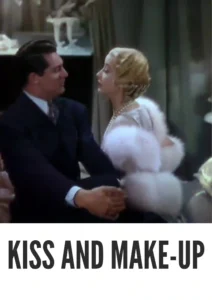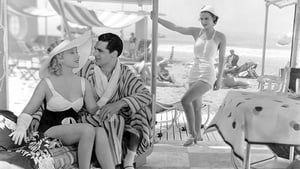Contact: [email protected]
Video Sources 0 Views
- Kiss and Make-Up


Synopsis
Table of Contents
ToggleReview: Kiss and Make-Up (1934) – A Charming Romantic Comedy Revived in Living Color

Introduction
“Kiss and Make-Up” (1934) is a delightful romantic comedy that showcases the comedic talents of its stars and the charm of classic Hollywood cinema. In this article, we’ll explore the significance of this early colored film and its enduring appeal to audiences of all ages.
Check The Full Colorized Movies List
Check Our Colorized Movies Trailer Channel
Understanding Kiss and Make-Up 1934: Director, Cast, and Genre
Directed by Harlan Thompson, “Kiss and Make-Up” (1934) exemplifies the wit and sophistication of screwball comedies from the Golden Age of Hollywood. The film features a talented cast, including Cary Grant and Helen Mack, whose on-screen chemistry and comedic timing elevate the story to new heights. Blending elements of romance, humor, and satire, “Kiss and Make-Up” (1934) offers a charming glimpse into the glamorous world of high society and the complexities of love and relationships.
Exploring the World of Kiss and Make-Up 1934: Plot and Characters
At its heart, “Kiss and Make-Up” (1934) follows the misadventures of a charming cosmetics expert, played by Cary Grant, who finds himself entangled in a web of romantic entanglements and mistaken identities. When his latest invention threatens to disrupt his carefully crafted world, he must navigate a series of comedic mishaps and madcap escapades to set things right. Along the way, he encounters a colorful cast of characters, each more eccentric than the last, who add to the film’s comedic charm and heartfelt moments.
The Art of Film Colorization
Film colorization has long been a contentious issue in the world of cinema, with purists arguing that it compromises the artistic integrity of classic films. However, when done tastefully and with respect for the original work, colorization can breathe new life into beloved movies, offering viewers a fresh perspective on familiar stories. In the case of “Kiss and Make-Up” (1934), the decision to release the film in a colorized format opens up new avenues for appreciation, allowing audiences to experience the glamour and charm of classic Hollywood in vibrant hues.
Early Colored Films: A Brief History
The history of colored films dates back to the early days of cinema, with filmmakers experimenting with various techniques to add color to their creations. From hand-painted frames to early Technicolor processes, the evolution of colored film has been marked by innovation and ingenuity, paving the way for the development of modern colorization techniques that continue to captivate audiences to this day.
Kiss and Make-Up 1934 and Its Early Colored Version
The decision to release “Kiss and Make-Up” (1934) in a colorized format was met with both anticipation and apprehension. While some welcomed the opportunity to experience the film in vibrant color, others expressed concerns about the potential impact on its visual aesthetic. Nevertheless, the early colored version of “Kiss and Make-Up” (1934) offers viewers a fresh perspective on the timeless tale of love and laughter, enhancing its comedic charm and bringing its glamorous world to life in stunning detail.
The Debate Over Film Colorization
The debate over film colorization is a complex and multifaceted issue, with passionate arguments on both sides of the divide. Proponents argue that colorization revitalizes classic movies for modern audiences, breathing new life into timeless stories and introducing them to a new generation of viewers. Conversely, detractors maintain that colorization detracts from the authenticity of the original work, altering the director’s artistic intent and diminishing the historical significance of the film.
Examining Kiss and Make-Up 1934 as an Early Colored Film
As with any colorized classic, the impact of colorization on “Kiss and Make-Up” (1934) is a matter of personal interpretation. Some may argue that it enhances the film’s visual appeal and immerses viewers in its world, while others may feel that it detracts from the charm of the original black and white version. Regardless of one’s stance on the issue, there’s no denying the enduring power of “Kiss and Make-Up” (1934) as a timeless romantic comedy that continues to captivate audiences with its wit, charm, and irresistible humor.
Influence and Legacy: Kiss and Make-Up 1934’s Impact on Cinema
“Kiss and Make-Up” (1934) has left an indelible mark on the world of cinema, inspiring countless filmmakers and captivating audiences with its timeless tale of love and laughter. From its sparkling dialogue to its unforgettable performances, the film continues to resonate with viewers of all ages, reaffirming its status as a beloved classic of the romantic comedy genre.
Director’s Cinematic Legacy: Beyond Kiss and Make-Up 1934
Harlan Thompson’s influence extends far beyond “Kiss and Make-Up” (1934), with a diverse body of work that continues to captivate audiences around the globe. From screwball comedies to musicals, Thompson’s films are celebrated for their wit, charm, and sophisticated humor, solidifying his legacy as one of the preeminent directors of Hollywood’s Golden Age. Through his groundbreaking work, Thompson has left an indelible imprint on the world of cinema, inspiring generations of filmmakers to follow in his footsteps.
Themes Explored in Kiss and Make-Up 1934
“Kiss and Make-Up” (1934) explores a myriad of themes, from the transformative power of love to the complexities of human relationships. Through its witty dialogue and endearing characters, the film invites viewers to ponder the nature of love, friendship, and the pursuit of happiness in a world filled with laughter and tears. As audiences immerse themselves in the world of “Kiss and Make-Up” (1934), they are reminded of the enduring truths that bind us together and the timeless appeal of a good old-fashioned romantic comedy.
Reception and Controversy Surrounding Kiss and Make-Up 1934
Upon its release, “Kiss and Make-Up” (1934) received widespread critical acclaim, with many praising its sparkling wit, charming performances, and delightful humor. However, the decision to release the film in a colorized format sparked debate among purists, reigniting the age-old discussion surrounding film preservation and artistic integrity. Despite the controversy, “Kiss and Make-Up” (1934) remains a beloved classic that continues to resonate with audiences of all ages, reaffirming its status as a timeless masterpiece of the romantic comedy genre.
Where to Watch Kiss and Make-Up 1934 Online
For those eager to experience the timeless charm of “Kiss and Make-Up” (1934), the film is readily available on popular streaming platforms such as Netflix, Amazon Prime, and Hulu. Whether you choose to watch it in its original black and white format or the early colored version, “Kiss and Make-Up” (1934) promises to whisk you away on a delightful journey of love, laughter, and romance.
FAQs About Kiss and Make-Up 1934
Q: Is “Kiss and Make-Up” (1934) based on a true story? A: No, “Kiss and Make-Up” (1934) is a fictional romantic comedy crafted by screenwriters who drew inspiration from the world of high society and the complexities of human relationships.
Q: Who are the main actors in “Kiss and Make-Up” (1934)? A: “Kiss and Make-Up” (1934) features a talented ensemble cast led by the charismatic Cary Grant and the charming Helen Mack, whose on-screen chemistry and comedic timing make for an unforgettable cinematic experience.
Q: What awards did “Kiss and Make-Up” (1934) win? A: While “Kiss and Make-Up” (1934) did not win any major awards, it received critical acclaim for its sparkling wit, delightful humor, and endearing performances.
Q: Why was “Kiss and Make-Up” (1934) released in a colorized format? A: The decision to release “Kiss and Make-Up” (1934) in color was made to introduce the film to a new generation of viewers and enhance its visual appeal for modern audiences. While the choice to colorize the film sparked debate among purists, it ultimately allowed “Kiss and Make-Up” (1934) to reach a wider audience and ensure its continued relevance in the annals of cinematic history.
Conclusion
“Kiss and Make-Up” (1934) remains a timeless classic that continues to enchant audiences with its wit, charm, and irresistible humor. Whether viewed in its original black and white format or the early colored version, the film serves as a delightful reminder of the enduring power of love and laughter to brighten even the darkest of days. So, grab your popcorn, sit back, and prepare to be whisked away on a delightful journey of romance, laughter, and endless entertainment with “Kiss and Make-Up” (1934).











